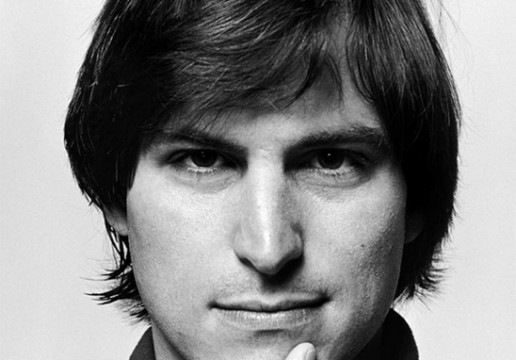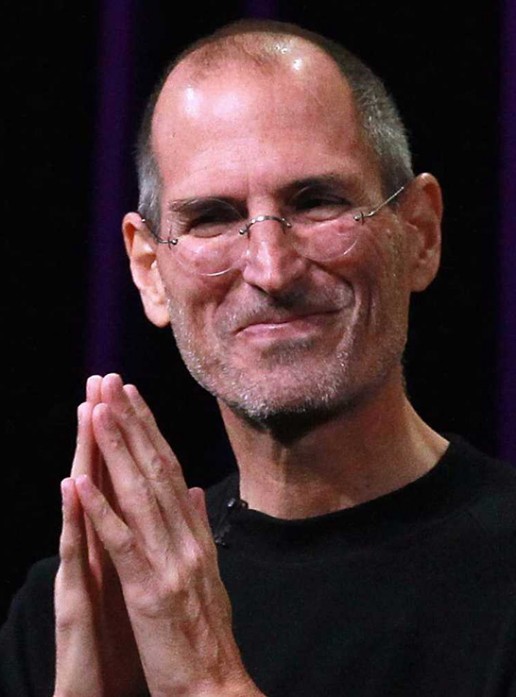Steve Jobs is a man who hardly needs an introduction. After all, he’s arguably the most important inventor and innovator this country has seen since the days of Thomas Edison and Henry Ford. Like Edison with the light bulb and Ford with the automobile, Jobs transformed society when he helped to bring about the home computer revolution starting in the late 1970s and early 1980s. For those born after this revolution it’s hard to imagine what life must have been life before Jobs–and even five years since his passing, it’s hard to imagine another figure who continues to exert as much influence on our daily lives as he does.

Jobs was born on this date in 1955 in San Francisco to a father who was a Syrian immigrant from a prominent family and a mother of Swiss and German heritage. Once the child was born he was adopted by Paul and Clara Jobs, both of whom had blue-collar backgrounds and no college education between them. Growing up in the Bay Area, Jobs was a brilliant yet unfocused youth who had a tough time relating to his peers or getting along with authority figures. Nonetheless his facility with electronics and interest in the arts led him to cultivate a circle of friends that included Steve Wozniak, later his fellow Apple co-founder, and Chrisann Brennan, later the mother of Jobs’s first child.
In 1974, Jobs reconnected with Wozniak when both began working for the video game developer Atari. In that same year Jobs left the company for a time in order to “find himself” in India, where his lifelong study of Zen Buddhism began. Upon returning from India, Jobs continued working with Wozniak on Atari projects while simultaneously developing the “blue box” prototype that led to the invention of the Apple I computer. In 1976, Jobs, Wozniak and Ronald Wayne formed the Apple Computer company in the garage of Jobs’s Los Altos home. Much like Edison’s Menlo Park, that humble garage would become one of the most well-known invention sites in American history.
Between 1976 and 1985, Jobs and Wozniak laid the groundwork for the home computer revolution to come. The two worked during this time to make computers less cumbersome, more sophisticated and affordable enough to be purchased by everyone. While Wozniak handled the nuts-and-bolts aspects of making personal computers possible, Jobs handled the marketing and promotion side of Apple. Jobs raised Apple’s valuation and made it a publicly traded company. However, later faulty product rollouts and consumer dissatisfaction motivated Apple executives to force Jobs out of the company he helped found. This setback forced Jobs to retrench during the late 1980s and much of the 1990s. Among his accomplishments during this period was the creation of NeXT, a software company later absorbed by Apple, and an animation company that would eventually become Pixar. Shortly after Apple bought NeXT in 1996, Jobs reclaimed the role as Apple CEO. And the rest, as the saying goes, was history.

The successes of Jobs’s second tenure, which lasted from 1997 until his death in 2011, are far too many to summarize here. During the course of his tenure as CEO and chief spokesman, Apple has become the most valuable company in the world, with a current market capitalization of over $625 billion. Jobs’s outsized role in both the tech world and in culture was such that the world stopped when he was diagnosed with cancer in 2003. Despite struggling with the disease for the rest of his life, Jobs was still able to bring innovations like the Macbook Air, iPod and iPhone to a gleeful public.
By the time of his death in 2011, his signature look of black mock turtleneck, blue jeans and sneakers had become as iconic as his products. Jobs has been immortalized in numerous biographies, histories, documentaries and feature films; he’s been the subject of four films and portrayed by actors as diverse as Noah Wyle, Ashton Kutcher, Justin Long and Michael Fassbender. In short, Steve Jobs is a seminal figure that helped change the world just as previous innovators like Edison and Ford had, and as such deserves to be remembered today on what would’ve been his 62nd birthday.
Panduan Lengkap Memilih Situs Slot Online Terpercaya di Indonesia
Jika Anda sedang mencari platform slot online terbaik untuk bermain game favorit Anda, Anda berada di tempat yang tepat! Dengan begitu banyak pilihan di luar sana, menentukan situs yang benar-benar layak menjadi tempat bermain bisa terasa membingungkan. Jangan khawatir—panduan ini akan membantu Anda menemukan situs slot online terpercaya di Indonesia. Yuk, kita mulai!
Mengapa Penting Memilih Situs Slot Online yang Tepat?
Sebelum membahas lebih jauh, mari kita pahami mengapa memilih indobet indobet yang terpercaya sangat penting. Dunia judi online penuh dengan peluang, tetapi tidak semua platform memiliki kualitas yang sama. Berikut adalah alasan utama mengapa Anda harus hati-hati dalam memilih:
-
Keamanan dan Fair Play
- Situs indobet indobet.bid online menjamin keamanan data pribadi dan uang Anda.
- Platform berlisensi memastikan permainan yang adil, sehingga peluang menang Anda tidak dimanipulasi.
-
Kemudahan dan Kenyamanan
- Situs terbaik online slot menawarkan proses transaksi yang mudah, opsi pembayaran beragam, dan antarmuka yang ramah pengguna.
- Anda bisa bermain dengan tenang tanpa gangguan teknis yang tidak perlu.
-
Beragam Pilihan Game
- Platform terpercaya slotvip slotvip.bid menyediakan berbagai macam permainan, dari slot online hingga permainan kasino klasik seperti poker dan blackjack.
-
Bonus dan Promosi Menarik
- Situs eslot eschenbach.cz yang baik memberikan bonus menarik seperti cashback, free spin, atau promosi harian yang memperbesar peluang Anda untuk menang.
Ciri-Ciri Situs Slot Online Terpercaya
Agar tidak salah memilih, berikut adalah beberapa ciri utama yang harus Anda perhatikan saat mencari situs eslot online bdh-advies.nl terpercaya:
- Lisensi dan Regulasi: Pastikan situs memiliki lisensi resmi dari otoritas yang diakui seperti PAGCOR, MGA, atau Curacao eGaming. Lisensi ini menjamin transparansi dan memastikan bahwa situs beroperasi sesuai standar internasional.
- Kerjasama dengan Provider Game Terkenal: Situs terpercaya biasanya bekerja sama dengan provider ternama seperti Pragmatic Play, Microgaming, atau Habanero. Game dari provider terkenal gemoy138.sbs memiliki kualitas grafis tinggi, fitur menarik, dan gameplay yang mulus.
- Layanan Pelanggan yang Responsif: Pilih situs dengan layanan pelanggan 24/7 yang dapat dihubungi melalui live chat, email, atau telepon. Respon cepat menunjukkan bahwa situs tersebut peduli pada kebutuhan pemainnya.
- Kompatibilitas Mobile: Pastikan situs gemoy138 mueblesamets.com mendukung permainan di perangkat seluler agar Anda bisa bermain kapan saja dan di mana saja. Situs yang baik biasanya memiliki aplikasi atau website yang dioptimalkan untuk perangkat mobile.
- Metode Pembayaran Lengkap: Situs terpercaya menyediakan berbagai opsi pembayaran seperti transfer bank, e-wallet, hingga cryptocurrency. Proses deposit dan penarikan yang cepat adalah nilai tambah.
- Keamanan Tingkat Tinggi: Cari situs indowin88jp vpct.utad.pt yang menggunakan teknologi enkripsi modern seperti SSL untuk melindungi data pribadi dan keuangan Anda.
Kategori Game yang Bisa Anda Nikmati
Setelah menemukan situs yang tepat, saatnya menikmati beragam kategori permainan yang tersedia. Berikut beberapa jenis permainan yang populer:
- Slot Online: Pilih dari slot klasik 3-gulungan hingga slot video modern dengan tema yang beragam. Banyak situs juga menawarkan jackpot progresif dengan hadiah yang menggiurkan.
- Permainan Kasino: Penggemar kasino dapat mencoba permainan seperti blackjack, roulette, baccarat, dan poker. Beberapa situs menyediakan kasino live dengan dealer sungguhan untuk pengalaman yang lebih nyata.
- Taruhan Olahraga: Pecinta olahraga bisa bertaruh pada tim favorit mereka di berbagai pertandingan, dari sepak bola hingga bola basket.
- Game Tembak Ikan: Permainan ini menggabungkan kesenangan dan strategi saat Anda berburu ikan untuk mendapatkan hadiah besar.
- Togel Online: Togel adalah permainan yang sangat populer di Indonesia, menawarkan kesempatan besar untuk menang dengan angka keberuntungan Anda.
- Sabung Ayam: Untuk yang mencari sesuatu yang unik, beberapa situs miammiam indobet.cfd menawarkan taruhan sabung ayam. Dukungan pelanggan ini memastikan bahwa setiap kendala yang Anda alami, baik saat bermain slot gacor maupun saat mendaftar akun baru, dapat segera diatasi.
Langkah-Langkah Memulai Bermain
Berikut adalah langkah sederhana untuk mulai bermain di situs slot online terpercaya:
- Daftar Akun: Klik tombol “Daftar” di halaman utama situs. Isi data yang diperlukan seperti nama, email, dan nomor telepon Anda.
- Lakukan Deposit: Pilih metode deposit yang tersedia dan masukkan jumlah uang yang ingin Anda setorkan. Beberapa situs menawarkan deposit minimum yang sangat terjangkau, cocok untuk pemula.
- Klaim Bonus Anda: Jangan lupa memanfaatkan bonus selamat datang atau promosi lain yang ditawarkan. Bonus ini bisa menambah saldo Anda!
- Pilih Permainan: Jelajahi koleksi game yang tersedia dan pilih yang sesuai dengan selera Anda. Banyak platform memungkinkan Anda mencoba game dalam mode demo sebelum bermain dengan uang asli.
- Mulai Bermain dan Tarik Kemenangan: Nikmati permainan apk slot online dengan bijak. Jika Anda menang, proses penarikan dana biasanya cukup mudah dan cepat.
Tips untuk Meningkatkan Peluang Menang
Meski permainan slot bergantung pada keberuntungan, beberapa tips ini bisa membantu Anda bermain lebih efektif:
- Pahami Aturan Game: Luangkan waktu untuk mempelajari cara kerja game, termasuk paylines dan fitur bonusnya.
- Gunakan Bonus dengan Bijak: Manfaatkan bonus atau free spin untuk bermain lebih lama tanpa mengeluarkan biaya tambahan.
- Mulai dengan Taruhan Kecil: Cobalah bertaruh dengan nominal kecil terlebih dahulu untuk memahami ritme permainan.
- Tetapkan Anggaran: Pastikan Anda menentukan batasan pengeluaran sebelum mulai bermain, dan patuhi anggaran tersebut.
- Berhenti di Waktu yang Tepat: Jika Anda sudah mencapai target kemenangan atau kerugian, jangan ragu untuk berhenti. Bermain secara bertanggung jawab sangat penting.
Keuntungan Bermain di Situs Terpercaya
Situs slot online terpercaya di Indonesia menawarkan berbagai keuntungan yang tidak bisa Anda dapatkan di tempat lain:
- Permainan Berkualitas: Akses ke berbagai game terbaik dari provider terkenal.
- Bonus Menggiurkan: Promosi harian, mingguan, hingga program loyalitas untuk pemain setia.
- Transparansi: Permainan yang adil tanpa manipulasi hasil.
- Keamanan Maksimal: Data pribadi dan transaksi Anda dilindungi dengan teknologi mutakhir.
Selain itu, situs slot online terpercaya juga memberikan layanan pelanggan yang responsif dan profesional, siap membantu Anda selama 24 jam setiap hari. Dengan dukungan tim yang handal, Anda tidak perlu khawatir menghadapi kendala teknis atau pertanyaan seputar akun dan permainan. Kombinasi antara kenyamanan, keamanan, dan layanan unggulan ini menjadikan pengalaman bermain Anda semakin menyenangkan dan bebas dari kekhawatiran.